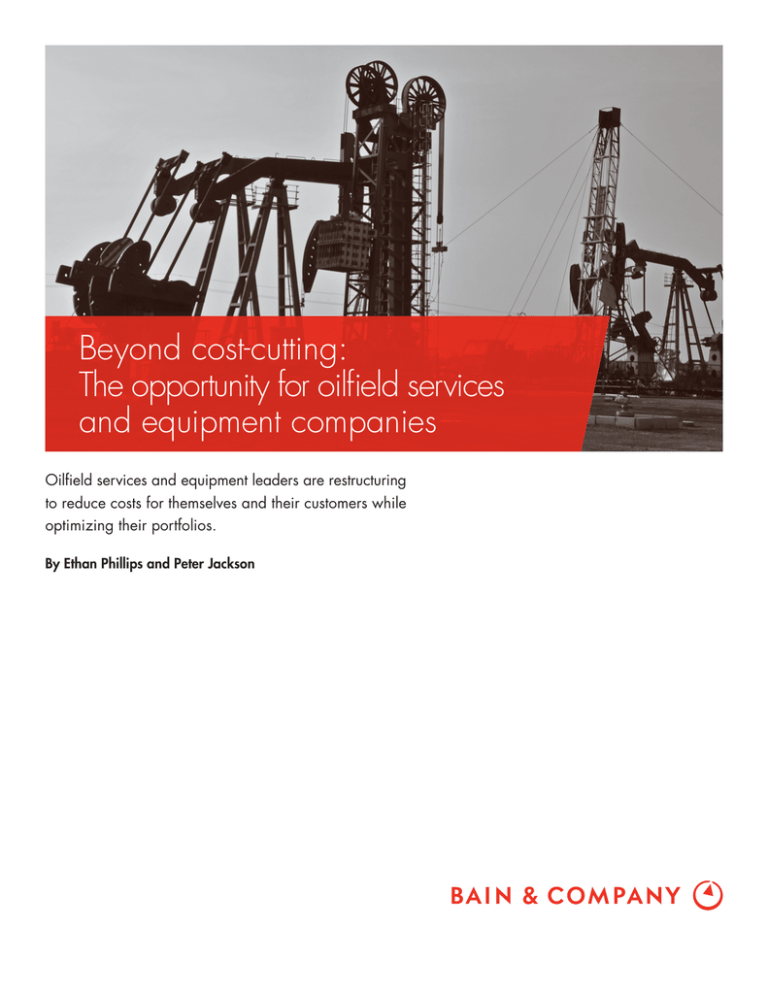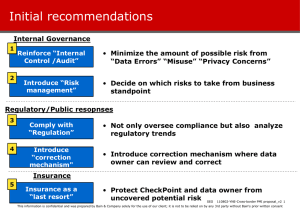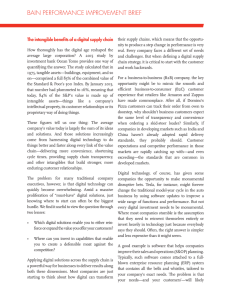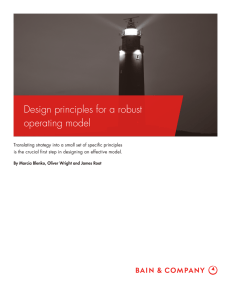
Beyond cost-cutting:
The opportunity for oilfield services
and equipment companies
Oilfield services and equipment leaders are restructuring
to reduce costs for themselves and their customers while
optimizing their portfolios.
By Ethan Phillips and Peter Jackson
Ethan Phillips is a Bain partner in Houston, and Peter Jackson is a partner with
Bain & Company in London. Both work with the firm’s Global Oil & Gas practice.
Copyright © 2015 Bain & Company, Inc. All rights reserved.
Beyond cost-cutting: The opportunity for oilfield services and equipment companies
Despite this, many OFSE providers left themselves
poorly positioned by allowing costs to rise along with
pricing and orienting themselves to higher-cost, technically challenging applications—profit pools that may
disappear for years in a low-price environment.
Upstream oilfield services and equipment (OFSE) companies have been among the hardest hit in the energy
sector since the start of the most recent oil price decline
in mid-2014. Their revenues have fallen significantly as
exploration and production (E&P) customers have slashed
Capex and activity levels and pressured suppliers to cut
pricing. In fact, the leading OFSE companies saw a collective 25% drop in revenue from the second quarter of
2014 to the same quarter in 2015. Margins have also
declined, though they have started to rebound in some
subsectors as service providers have reduced costs. In
total, the sector lost more than $130 billion in market
capitalization, with some segments hit harder than
others (see Figure 1).
When prices fell, OFSE executives followed their triedand-true downturn playbooks. They cut capacity, reduced
headcount and overhead, and tightened capital budgets
as they waited for a recovery. But many have started to
awaken to the fact that the industry is at a once-in-a-generation strategic crossroads that demands conscious and
careful decisions about the future. The current downturn could well rival that of the 1980s in duration, and
oil prices are likely to remain low for some time—well
into 2016 and perhaps beyond.
Until the recent price decline, the OFSE sector had experienced a relatively smooth trajectory over the past
decade: Upstream operators outsourced much of the
work across a growing industry, and operators paid a
premium for availability as activity levels outpaced capacity. As a result, prices for equipment and services soared,
and OFSE returns—though cyclical—were above normal.
The industry that emerges from this low-price environment will look quite different from the one that entered
it. Lower-cost volumes, particularly from the Middle
East, may continue to be strong, and North American
tight oil, while challenged at current prices, will remain
Figure 1: While nearly all segments of the oilfield services sector have seen their revenues fall, some
have been hit harder than others, particularly in well services, drilling, procurement and topside processing
Oilfield services & equipment market, select segments, 2015 forecast (billions of dollars)
Operational services
Automation and
electromaintenance
Insulation, scaffolding and surface
100%
80
60
40
20
0
152
Offshore construction services
Platform drilling services
Brownfield modules/modification
Land workover rigs
Hull/structure construction
95
90
86
Facility leasing
Metal, pipe
and valve
maintenance
Jackups/
barges
Artificial lift services
Drilling services
Wireline and
geoscience services
Wellbore completion
and reentry services
Professional
services
Support
services
Well stimulation
services
Inspection
and
maintenance
Semi
submersibles
& drillship
Maintenance
services
Well services
Operational and
professional services
Land
rotary rigs
Rigs and
drilling
contractors
79
Specialty
chemicals
69
Drilling
tools
Drilling
fluids
Casing and
tubing steel
(OCTG)
Drilling
tools and
commodities
Topside
construction
Onshore
construction
services
Procurement, construction
and installation
Revenue decline (201415F)
>0%
05%
510%
1015%
1520%
<20%
Notes: Data calculated from consolidated E&P expenditures; other sectors include topside and processing equipment; transportation and logistics; subsea equipment and installation;
engineering; and seismic, geological and geophysical
Sources: Rystad Energy (October 27, 2015); Bain analysis
1
Beyond cost-cutting: The opportunity for oilfield services and equipment companies
Surveying the landscape
a significant part of new production growth. Deepwater
developments, however, are being radically reworked for
the new price environment. And frontier plays such as
arctic and ultra-deepwater—viewed as the industry’s next
wave of growth just a few short years ago—are unlikely
to be economical for quite some time, if ever.
The price drop that began in the middle of 2014 resulted
from an oversupply of crude oil as the resurgence of
production from Iraq, Libya and Iran—combined with
sustained production from the US and Canada—contributed to a growing surplus in the face of weakening
demand. Low-cost barrels from the Middle East and
Russia will continue to be the biggest factors affecting
price and production mix, and predicting those outputs
with any certainty is notoriously challenging given security and geopolitical instabilities.
For OFSE providers, the imperative now shifts away from
pushing technical boundaries at the frontiers to creating
efficiencies that allow them to operate sustainably over the
long term. Executives are looking beyond simple costcutting to determine what to do next to thrive in a prolonged period of price weakness. They are also looking
beyond their own organizations to find novel ways to lower
their customers’ costs through more efficient technologies and processes, and they are refocusing their portfolios
to reduce their exposure to high-cost sources and reposition themselves at the lower end of the cost curve.
Efficiency gains in North American tight oil and offshore
developments will also affect the price and production
mix. Many were surprised by the resiliency of North
American shale drilling as oil prices fell over the past
year. Some of this resiliency was due to hedging, highgrading and other factors. But the fact remains that
breakeven prices for North American tight oil declined
steadily as operators gained experience and technologies improved (see Figure 2). While the year-overyear gains will slow, the downward trend in Eagle
Ford looks similar to the one seen by shale gas operators in the Marcellus, and our experience working
with leading E&P companies suggests it has more room
to run. Projecting forward and combining with the lower
onshore services costs in the market (even assuming
some cost increase from current levels), acreage that required a price point of $75 per barrel to earn a return in
2014 could be economical at $55 or less. With prices
hovering below $50, North American tight oil drilling
has declined significantly and is unlikely to return to
2014 levels for the foreseeable future (if ever), but this
will remain an attractive source and will be one of the
first to see renewed activity once demand catches back
up with supply.
Executives are looking beyond simple
cost-cutting to determine what to do
next to thrive in a prolonged period of
price weakness.
These are inherently challenging moves to make in the
best of times. But they are all the more challenging in
the face of falling revenues and industry uncertainty.
What’s more, many firms have a narrow window to act—
while their balance sheets are robust enough to allow for
some flexibility.
Indiscriminate cost-cutting can diminish a firm’s capabilities and hamper its ability to grow as activity recovers.
Pursuing the wrong technologies wastes scarce resources
and can put a company at a serious competitive disadvantage. The right acquisitions and portfolio moves could
create a tremendous growth platform, but the wrong
ones could be a millstone around a company’s neck.
The outlook of offshore is less certain. There have
been some high-profile delays and cancellations, but
most projects that were already sanctioned continue to
move forward and offshore production volumes will
continue to rise. Over time, unfavorable economics
2
Beyond cost-cutting: The opportunity for oilfield services and equipment companies
Figure 2: Tight oil production is following a steep learning curve
Total cost of tight oil production (per BOE)
$1,000
500
2005
2006
200
2007
2010
2011
2012
100
2008
2013
2009
50
2014
20
10
0.001
0.01
0.1
1
10
100
Cumulative production from tight oil plays (BOE)
Notes: Estimates based on Rystad forecasts of unconventional shale oil production and expenditures; BOE is barrels of oil equivalent
Sources: Rystad Energy; Bain analysis
and smaller capital budgets will delay some projects,
though lower day rates and input costs will keep some
running. Operators are working to radically simplify
their designs and engineer cost to make the economics work at $50 per barrel. The industry will watch closely for signs of success as operators go through their capital planning processes next year.
•
zero-base budgets to ensure costs are aligned with
the most critical and valuable activities;
•
radically simplify their operational footprint, supply
chain and logistics and ensure alignment with new
activity outlook;
•
properly integrate acquisitions taken during the
recent growth period; and
While they wait, OFSE leaders can look at three broad,
strategic imperatives (see Figure 3).
•
create a core set of standardized and modularized products.
Most executives are already well into the first imperative,
the short-term need to reduce costs by cutting discretionary spending. Many are now looking for more ways
to simplify their operations and generate more sustainable efficiencies. Their goal is to create a leaner
organization that can thrive in a low-price environment
for years, coming out into a recovery in a stronger
position. Among the options:
Executives also need to reduce customer costs in a more
sustainable way, going beyond price reductions or trading margins for the duration. They should collaborate
closely with customers on a range of moves that radically
restructure the cost base of the industry by engineering
out cost, developing more efficient products and processes, and seeking novel business models to better
align with incentives. These tactics can include:
Three imperatives for OFSE companies
3
Beyond cost-cutting: The opportunity for oilfield services and equipment companies
Figure 3: Three key imperatives for oilfield services and equipment companies
Reduce internal costs
for the short term
Reduce customer costs
for the medium term
Optimize your portfolio
for the long term
Reduce costs
dramatically in
the short term
while maintaining
core capabilities
Invest in ways
to help clients
reduce costs
and increase
productivity
Position your portfolio
to withstand a longterm
market downturn
and to take advantage
of a recovery
Source: Bain & Company
•
developing integrated, just-in-time supply chains
to reduce total cost of operations;
•
exploring design-to-cost and value-engineering
approaches to engineer out costs;
•
identifying areas where customers’ standards are
driving significant costs and constructively challenge
them to find ways to achieve the same objectives
at lower cost;
•
looking for selective areas where technology can push
costs down, as with condition-based maintenance;
•
searching for ways to collaborate with customers
and explore novel business models that better align
incentives with customers; and
•
using advanced analytics to identify opportunities
to optimize equipment maintenance spend while
maintaining strict health, safety and environmental
(HSE) standards.
Finally, they should evaluate their business portfolio to
look for opportunities to reduce their exposure to price
volatility, fill key gaps in their offerings and create optionality to be able to respond effectively as the sector
eventually recovers. They may choose to reorient their
product and geographic portfolios toward the lower end
of the cost curve, building on reduced costs of engineering and manufacturing. Or they may proactively
identify potential M&A targets to build scale and scope
and move lower on the production cost curve. Some
equipment manufacturers, those for whom oil and gas
is only one market among many, may consider exiting
the market entirely.
All of these moves require bold thinking, strong, collaborative customer relationships and impeccable execution.
As with any serious disruption, the winners will be the
players who can spot opportunities and act quickly to
capture them. The current downturn will test oilfield
services and equipment executives, but those that take
the opportunity to maneuver into a better position will
thrive in the eventual recovery.
4
Shared Ambit ion, True Results
Bain & Company is the management consulting firm that the world’s business leaders come
to when they want results.
Bain advises clients on strategy, operations, technology, organization, private equity and mergers and acquisitions.
We develop practical, customized insights that clients act on and transfer skills that make change stick. Founded
in 1973, Bain has 53 offices in 34 countries, and our deep expertise and client roster cross every industry and
economic sector. Our clients have outperformed the stock market 4 to 1.
What sets us apart
We believe a consulting firm should be more than an adviser. So we put ourselves in our clients’ shoes, selling
outcomes, not projects. We align our incentives with our clients’ by linking our fees to their results and collaborate
to unlock the full potential of their business. Our Results Delivery® process builds our clients’ capabilities, and
our True North values mean we do the right thing for our clients, people and communities—always.
Key contacts in Bain’s Global Oil & Gas practice
Americas
Europe, Middle East and Africa
Riccardo Bertocco in Dallas (riccardo.bertocco@bain.com)
Lars Jacob Boe in Oslo (larsjacob.boe@bain.com)
Pedro Caruso in Houston (pedro.caruso@bain.com)
Luca Caruso in Moscow (luca.caruso@bain.com)
Ricardo Gold in São Paulo (ricardo.gold@bain.com)
Juan Carlos Gay in London (juancarlos.gay@bain.com)
Eduardo Hutt in Mexico City (eduardo.hutt@bain.com)
Lili Chahbazi in London (lili.chahbazi@bain.com)
Jorge Leis in Houston (jorge.leis@bain.com)
Peter Jackson in London (peter.jackson@bain.com)
Rodrigo Mas in São Paulo (rodrigo.mas@bain.com)
Christophe de Mahieu in Dubai (christophe.demahieu@bain.com)
John McCreery in Houston (john.mccreery@bain.com)
Raed Kombargi in London (raed.kombargi@bain.com)
John Norton in Houston (john.norton@bain.com)
Torsten Lichtenau in London (torsten.lichtenau@bain.com)
Ethan Phillips in Houston (ethan.phillips@bain.com)
Olya Linde in Moscow (olya.linde@bain.com)
José de Sá in São Paulo (jose.sa@bain.com)
Alain Masuy in Dubai (alain.masuy@bain.com)
Roberto Nava in Milan (roberto.nava@bain.com)
Asia-Pacific
Peter Parry in London (peter.parry@bain.com)
Sharad Apte in Bangkok (sharad.apte@bain.com)
Tiziano Rivolta in Milan (tiziano.rivolta@bain.com)
Francesco Cigala in Kuala Lumpur (francesco.cigala@bain.com)
Alasdair Robbie in London (alasdair.robbie@bain.com)
Lodewijk de Graauw in Perth (lodewijk.degraauw@bain.com)
Karim Shariff in Dubai (karim.shariff@bain.com)
Dale Hardcastle in Singapore (dale.hardcastle@bain.com)
Natan Shklyar in Moscow (natan.shklyar@bain.com)
Brian Murphy in Perth (brian.murphy@bain.com)
John Smith in London (john.smith@bain.com)
Andrea Petronio in Milan (andrea.petronio@bain.com)
Matt Taylor in London (matt.taylor@bain.com)
Luis Uriza in London (luis.uriza@bain.com)
For more information, visit www.bain.com









